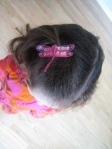Filed under: Uncategorized
Obviously this site is on ice for a bit. Please feel free to read my writings at:
www.Squidalicious.com | ThinkingAutismGuide.com | BlogHer.com
Warm regards,Shannon Des Roches Rosa
 Reviewed by Zelly Rosa, age eleven
Reviewed by Zelly Rosa, age eleven
When my mom first handed me Saving Hannah: Or How to Rewrite History by Andrea Stein, i was a little bit skeptical. The title made me suspect yet another “a group of girls, one of their friends disappears and they have to find her” story. but after I opened the cover, my suspicions were erased. From the first page, this book was in my hands until it was over. I really loved how the girls in the story were proud of who they were and did not pretend to be someone else because they considered themselves not good enough. These girls inspire me to be a better person.
The many plot twists and turns provide a break from the normally predictable “mysteries” that I read and had trouble telling apart. The book was extremely creative, and I especially like how they included a few details about fashion and did not seem to imply that fashion and makeup are bad. Rose, Daisy, Lilly, and Poppy are four girls everyone should have the chance to read about.
Filed under: health | Tags: American Heart Association, autism, Brand About Town, health, Nintendo, Wii
I am a health-slacker from a family with nasty heart problems. It is not a great combination. I know I need to be careful, and I know exactly what I should be doing to take better care of my health, but a kick-in-the-pants reminder about prioritizing well-being is always welcome. So, when lovely Justine from Brand About Town asked me if I’d like to attend a Nintendo & American Heart Association-sponsored health event at the W San Francisco, I said yes, please!
Jenijen came with me, as she was miraculously available. We rode to San Francisco in a cushy shuttle arranged by Wii ambassador Kim Postlewaite from Tippy Toes and Tantrums, whose company I always enjoy. Jen & I talked about how we both gravitate away from complainers and towards non-complainers, how that trickles down into asking our kids to tell us what they do like and do want — instead of moaning about what they don’t like and don’t want. An eerily prescient conversation, as you will see.
Upon arrival, we were asked if we’d taken our Heart Health Survey — I had, but my crappy 5.7 out of 10 score meant I was too embarrassed to request the Heart Health Score pin that the 7+ scorers were nonchalantly sporting. We were served delicious honey yogurt, granola, and dried fruit parfaits — and not the chewing-on-bark kind, but the kind that makes me wonder why I don’t eat that way for breakfast more often since it involves assembly rather than cooking.
Then we got to play with the Wii and Wii Fits. I confessed to Jenijen that I’d never even seen a Wii IRL before, so she showed me how to use the controller, then used her veteran skills to wipe the floor with me on Wii Bowling. I could definitely see how the Wii could encourage couch-planted gamers to become more active — my hurt pride aside, the free-form play was a lot of fun. I could also see why fellow parents of kids with autism recommend the Wii, though I think my son Leo might have a hard time manipulating the controller. Regardless, I’m planning to mooch a session with Leo at a Wii-owning friend’s house, ASAP.
Then we were ushered into the speakers room a scrumptious healthy lunch — grilled chicken with a fruity sauce over a variety of grains mixed with wilted greens, nuts, and whole cooked grains — including the quinoa I already adore. Again, forehead slap — this kind of food is not difficult to prepare!
We listened as Hank Wasiak told us how to approach our health from the perspective of Asset-Based Thinking, which was similar to what Jen & I were discussing on the way to the event — getting away from negative, downside-focused “deficit-based thinking.” Here are some of Hank’s points, as they relate to taking charge of your own health*:
- Asset-based thinking is about focusing on what’s possible, and what’s working.
- You need behavior change to improve your health, and behavior change is not easy.
- You need to make desire more important than fear.
- You are the one who is in control of your health.
Then we had a Q&A session with four doctors whose specialties ranged from pediatric weight intervention to cardiac surgery & repairs. This was my favorite part of the entire event, and I was not alone in wishing we could have spent more time questioning the good-humored and incredibly knowledgeable doctors. Here are some of their points*:
- 82% of cardivascular disease is preventable through lifestyle changes.
- 1 in 3 women will die from cardiovascular issues — as opposed to, for instance, 1 in 41 from breast cancer. Life-threatening cardiovascular disease is much more common than cancer, and we need more awareness of this risk.
- 73% of women who have heart attacks have symptoms in the previous month, usually unusual tiredness or insomnia — so if you start seeing these symptoms, you need to be diligent and assertive in having your doctor evaluate your cardiac health.
- 43% of women have no chest pain even in the middle of a heart attack.
- Stress is a big factor in heart health.
- Today’s children are the first generation that may have shorter life expectancies than their parents, due to obesity.
- Children as young as three years old are now developing plaques in their arteries.
- Modeling for your kids is important when it comes to healthy food habits, in terms of portion sizes and food choices. Practice what you preach, what you want them to learn.
- Kids are motivated by “food justice,” older kids can read books like Omnivore’s Dilemma, teens can see Super-Size Me.
- Salt is an acquired taste, like sugar.
- Sodium is mostly an issue with processed foods, but this is not always obvious with items like bread. Read labels.
- High Fructose Corn Syrup tricks your body into taking in more sugar calories than regular sugar, because fructose bypasses you body’s normal sugar regulatory system, and your body doesn’t register all those extra fructose calories as “sugar.” For more information, see UCSF’s Robert Lustig’s work on Sugar and Obesity.
Even though we all wanted to keep drilling the doctors, our time was up. But it wasn’t too much of a hardship, as it was time for more Wii madness and a tasty dessert of gingered-lime fruit salad and smoothies. We also got to write letters to ourselves, which the AHA people will be mailing us in a few months. Mine said, “You will take action to get your cholesterol under control through diet and exercise or else you will be obligated to publicly humiliate yourself on you blog.” But I won’t have to do that, thanks to all the excellent tips, info, and guidance we received during the event — right?
The website of the American Heart Association, Heart.org, contains many resources for helping evaluate, improve, and maintain heart health.
*Practical disclaimer: My notes are not a literal transcript of the event, and many contain errors or omissions.
Filed under: review
I do not dress like a girly girl. I usually sport jeans, t-shirts, solid colors, lots of brown and black. Basic black flip flops in the summer, basic black Dr. Martens in the winter. The opposite of fancy.
Which is why I find it challenging to outfit Leo’s little sister, five-year-old Mali. Her style is completely different from mine. She craves all that is glittering, pink, patterned, and fancy. She recently re-christened her shiny stuffed gecko “Celine Lizon” because Mali, like fellow magpie like Fug Girl Jessica, embraces Celine Dion as the apex of sparkly fabulousness.
I have been fortunate in that Mali has inherited much of her older sister Iz’s rather impressive wardrobe, but still wondered if perhaps I should let Mali have some fabulous of her own. So I was relieved when the the folks at Lady Bugs N Butterflies contacted me to ask if Mali would like to try out a couple of their hair clips. Would she? Does Celine Dion hail from the land of poutine? YES!
Mali was thrilled. Even more so when we went to the Lady Bugs N Butterflies site and discovered that she got to customize her clips from a wide selections of decorations, colors, and fasteners. After about an hour, Mali narrowed her choices to two (glittering, pink, patterned, fancy) options:

Polka dot “clippy” (Mali’s term)

Dragonfly clippy (which I have to admit to loving)
 And such a happy girl, to have such fabulous accessories!
And such a happy girl, to have such fabulous accessories!
(Mali is wearing the polka dot clippy.)
Mali received two complimentary hair clips from Lady Bugs n Butterflies, but our family was in no other way compensated for this review.
Filed under: Uncategorized | Tags: autism, Holly Robinson Peete, My Brother Charlie
 Hurrah and congratulations to the three contest winners who will be receiving copies of My Brother Charlie, the new children’s book about autism by Holly Robinson Peete & Ryan Elizabeth Peete!
Hurrah and congratulations to the three contest winners who will be receiving copies of My Brother Charlie, the new children’s book about autism by Holly Robinson Peete & Ryan Elizabeth Peete!
In first place is Christina Faria, who will be winning the signed copy of My Brother Charlie. Here is what Christina said:
This gave me a much needed smile today. I can’t wait to get my hands on my own copy of the book. Too cute!
Second place winner Rose Deduyo will get a regular copy of the book. Her comment was touching:
I would like to have a copy of the book because I would like to know what is like to have a typical child at home & how it feels to have someone who child like nature to help an autistic child/sibling.
We have a 6.5 years old Daniel who has been diagnosed with Autism. We have no relatives around, no neighbors in the community who has typical child so Daniel will have a role model, whom he can “play with.”. At least through reading a book like My Brother Charlie by HRP, I could at least imagine and dream deep in my heart that Daniel has someone who could teach him how to play the truck, race cars, run with another child, how to play soccer at the point of view of a typical child. Thank you .
Third place winner Stephanie will be sending her regular copy of the book to her sister, an early education teacher:
My sister collects children books and teaches early education and I think this would be an excellent addition to her collection to teach children.
I will send along the winners’ email addresses to the powers that be; you all should hear from them shortly.
Thank you to everyone who entered. Thanks also to Holly and Ryan for their generosity. I am so glad the books will be going to good homes, that My Brother Charlie’s message of autism acceptance and love will be reaching so many people!
—
Winners were chosen via Random.org. If you would like to verify that you were indeed entered into the drawing, enter the email address from your comment into this contest’s Random.org verification page.
 If you arrived here via my Squidalicious Holly Robinson Peete interview about My Brother Charlie, welcome! If not, please go read the interview. HRP is so wise and thoughtful and inspiring; I left the interview feeling re-energized about promoting autism acceptance for my son and his peers.
If you arrived here via my Squidalicious Holly Robinson Peete interview about My Brother Charlie, welcome! If not, please go read the interview. HRP is so wise and thoughtful and inspiring; I left the interview feeling re-energized about promoting autism acceptance for my son and his peers.
HRP is also very generous — she is offering one signed copy and two additional copies of My Brother Charlie to you lucky readers. If you’d like to win one of the three copies, please leave a comment below, and tell us why you’d like your own copy of this sweet, necessary children’s book. [Update 4.24: The contest is now closed; congratulation to the winners! -SR]
You may comment until 11:59 PM on Wednesday, April 21st. I will randomly select and announce the winners on this site on Thursday, April 22nd.
Here’s the official word on My Brother Charlie:
Holly Robinson Peete, bestselling author, actress, and national autism spokesperson, has paired with her daughter, Ryan, to co-author this uplifting book based on their own personal experiences with Holly’s son and Ryan’s brother, RJ, who has autism. In this story, told from a sister’s point of view, we meet a family whose oldest son teaches them important lessons about togetherness, hope, tolerance, and love.
Here is what Holly and her co-author daugther Ryan have to say about My Brother Charlie:
And here is Leelo’s little sister reading and reviewing My Brother Charlie, and also opining on how Charlie and her own brother are both similar and different:
Hardcover book retail value $16.99
Filed under: books, reading, review | Tags: Percy the Perfectly Imperfect Chicken, Rick Rieser
 If you stock your kids’ bookshelves like I do, they contain a colorful mix of tales both fanciful and educational. Books like Percy, the Perfectly Imperfect Chicken, Rick Rieser’s new FastPencil release about a chicken who doesn’t fit in.
If you stock your kids’ bookshelves like I do, they contain a colorful mix of tales both fanciful and educational. Books like Percy, the Perfectly Imperfect Chicken, Rick Rieser’s new FastPencil release about a chicken who doesn’t fit in.
I accepted a review copy of Percy with hopes that a book about creatures “perfectly imperfect” would carry a message of acceptance towards those who act or look in ways “typical” creatures find strange. I read Percy with my youngest daughter, who is almost-five, and we were both taken with Daniel Seward’s vibrant illustrations as well as the cute barnyard scene: an egg hatches! The chickens all gather round to greet the newest member of their flock!
Then a trio of older hens struts forth and scrutinizes Percy, declaring that they need to see him, as only perfect chickens are allowed to stay in their yard. Percy’s mom insists that her son is fine, and so he appears to be at first. Or is he? Unsurprisingly, I was hoping for an unsubtle special needs parallel … and was disappointed when Percy’s difference is revealed to be a matter of minor cosmetics. However, I am not a chicken, and I do not live in a world where a small variation in my appearance would get me ejected from my home.
Percy’s mom continues to protect him. When he reaches adulthood, he flies above the barnyard and is treated to views he’d never before encountered — including those of the three governing hens. From his new perspective, he sees that each hen has one of the forbidden imperfections, and confronts them.
I admit to a bit of discomfort with those scenes. We try to run a positive-thinking household, and pointing out someone’s else’s imperfections — even during self-advocacy — is not something we model. But it is also important that our children learn to recognize and reject hypocrites, especially those who wield influence or power. Otherwise, our kids will be taught to strive for that which they and indeed most people in their community do not represent (body image or materialism, anyone?). I want my kids to know that, as Percy’s mom says, “Perfect is something that doesn’t exist.”
Of course Mali doesn’t care about any of my analysis. She thinks Percy is an awesome book and reads it every day:
Coolness: Percy the Perfectly Imperfect Chicken was published through FastPencil.
Filed under: ABA therapy, autism, autism blog, behavioralist, Bridget Taylor, challenging behaviors, Rethink Autism
For many parents and families with children on the autism spectrum problem behavior can be challenging. That’s why this month’s free live webinar focuses on the best problem behavior treatment and prevention strategies available. You’ll learn how to begin immediately applying these techniques with your child and have a chance to ask questions via live chat with autism expert Dr. Bridget Taylor, a leader in the field of autism treatment and research, and rethink autism’s senior clinical adviser.Register for a webinar session now by clicking a date below:
All of the Rethink Autism’s teaching techniques and procedures are based on research that has been conducted in the field of applied behavior analysis. The techniques that I will discuss about managing challenging behavior are based on general principles of learning, and how challenging behavior is usually a result of the interaction between environment and behavior. That is, behavior occurs in relationship to certain events occurring in the environment. If we can identify those events and determine the reason for the challenging behavior, we can change behavior for the better. The pager prompt study is one example of how you can teach an individual with autism to attend to specific cues in the environment in order to reduce a behavior of concern. In this case eating too quickly.
Today is my 40th birthday. If I were the type who considered such milestones opportunities to dwell upon unachieved dreams, I would moan bitterly about the very cool new kids’ educational online world, Wonder Rotunda, and gripe bout why I should have been the one to create it given that I and my two Geography degrees have been creating and improving upon that which used to be called “edutainment,” for almost fifteen years.
Instead, I’ll pause to appreciate all the loveliness in my life, remark that contract gigs combining geography, education, and interactivity are my very favorite kind of paid endeavor, and commence with the review.
Wonder Rotunda is an online, exploration-based learning environment for kids age seven – twelvish who want to learn more about the world around them, or whose parents would like them to learn more and understand that game-like environments are very good carrots. Specifically:
“The Wonder Rotunda is a virtual, educational theme park designed to open the eyes of youngsters to the wonders of our world, much the way world’s fairs and expos did for prior generations. It is designed to get kids thinking about our world, finding things that they’re passionate about, and exploring how they might make their mark some day.
“Set on an island in New York Harbor, the Wonder Rotunda’s fifteen, interactive, animated adventures cover topics as diverse as tropical rainforests, African wildlife, marine life, the human body’s digestive system, money and business, American government, nutrition, globalization, film making, classical music, performing and visual arts, space exploration and, making a difference in the world. The adventures move briskly and with excitement, while affording youngsters the option of probing more deeply where they have the interest.”
Parents worried about Webkinz or Club Penguin-like unmonitored social environments will be pleased with Wonder Rotunda. Though it’s web-based, there are no social networking or commercial options, no advertising. And there are considerable parental controls, such as requiring parents to create their own, administrative account before the child’s account can be created, allowing parents to create their own avatar so they can tag along with their kids (the Wonder Rotunda folks liken it to visiting a museum together), and the ability to browse your child’s Wonder Rotunda’s trail, to see where they have been spending the most time — so you can tell what subjects they’re most interested in, and encourage them to pursue them.
I have to admit, given Wonder Rotunda’s squeaky-clean appearance, its earnest goals, and the home page’s tour, I have not felt the need to monitor my ten-year-old Iz as she explores Wonder Rotunda. She finds WR’s subject matter motivating, and has been tearing around all by herself, popping out occasionally to blurt newly acquired facts:”iguanas can fall from a height of 40 feet without getting hurt!” and decry the occasional factual error: “Thomas Jefferson was the third U.S. President, not the second, tell them that right now, Mommy!” (To their credit, the Wonder Rotunda staff fixed the error immediately. Gotta love online content.)
The graphics are nicely done, the content has depth (always a concern, Iz gets bored quickly), and — most tellingly — I had to rip Iz away from the screen so she could do her homework. This led to a debate about my priorities — did I want to send her brain chasing after the new facts, systems, and synergies Wonder Rotunda offered, or did I want it to stagnate in revisiting concepts and worksheets it had already mastered? I recommend that you avoid such scenarios by requiring that your children finish their homework before they get to “play” with Wonder Rotunda.
I approve of Wonder Rotunda‘s mission wholeheartedly. I would likely have purchased it for my kids independently, but we were gifted a one month unlimited access pass worth $12. (Unlimited access for one year is $45, and can be renewed each year for $35). If you have the kind of kids who love The Magic Schoolbus and The Discovery Channel — or are looking to nudge your kids in that direction — Wonder Rotunda is a safe, mentally enriching, fun place to send them.





